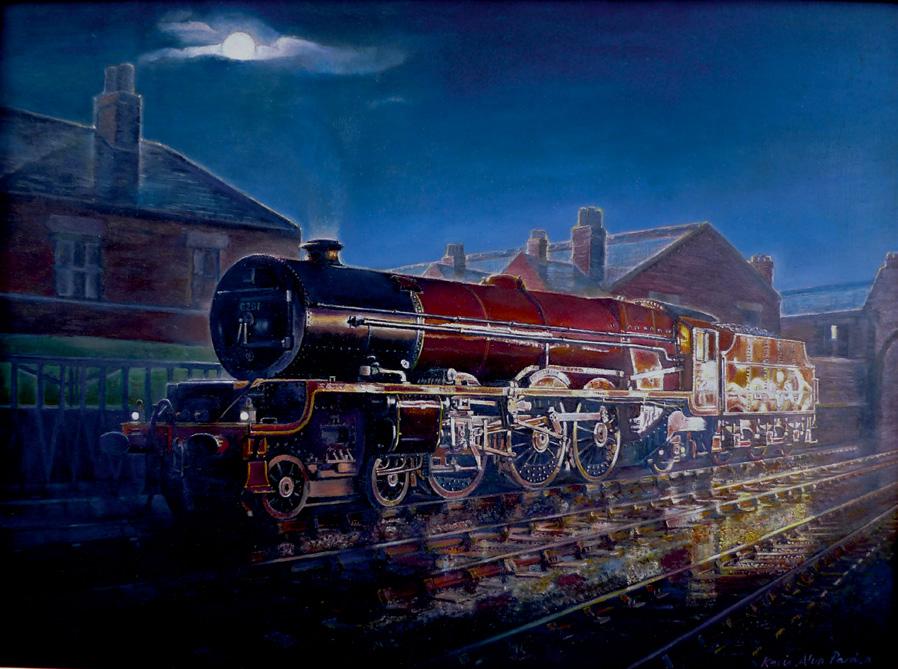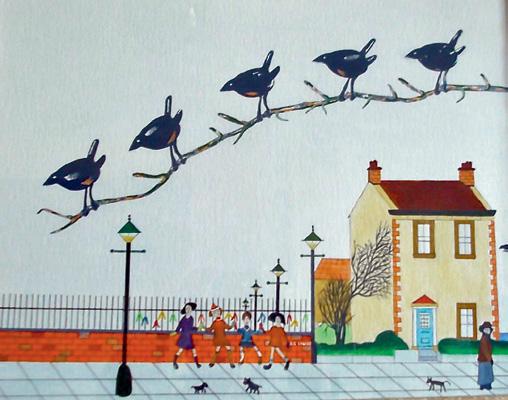
9 minute read
Art news miscellany
by the LMS Patriot Project (Fig.3). This project was established by railway enthusiasts to build a new national memorial engine, namely an LMS Patriot locomotive after all the original members of this class were scrapped with the demise of steam in the late 1960s. Train on Time portrays a Patriot Class Locomotive no 45551 named ‘The Unknown Warrior’ approaching which many might recognise to have been Warwick (Milverton) Station in Leamington Spa during the 1950s. The locomotive itself can be interpreted as a symbol of remembrance and a permanent memorial to all those people who have died because of past war events. Works such as Tornado and Clun Castle also ought to be highlighted for the ways in which they are allencompassing of the elements of the Earth. Kevin’s love for Doctor Who began at the early age of 10 when he first watched an episode of what went on to become a television phenomenon and legend in science fiction and fantasy. With its well written stories and strong characterisation, the show was compelling and engaging for the imaginative child that was Kevin. Beginning in the late 1990s, Kevin has created several montages of the television show and he still continues to do so to this day as the show is constantly evolving. This ignites his inspiration. Kevin’s artwork is known in the Doctor Who world through fandom, conventions, charity events and merchandise (Fig. 4). Kevin’s art embodies the various sources of inspiration that informed the artist’s vision of the world and our role within it. The longer

Advertisement

one chooses to contemplate one of Kevin’s painting, the more they wish to discover, and this is perhaps the ultimate sign of art that stands the test of time and can go beyond its own limitations of time and space.
Figure 3. Above: Train on Time (2011)
Figure 4. Left: The 13th Doctor (2019)
Kevin undertakes commissions and can be contacted at his studio on 01926 332708 or via email, parrish@quicknetuk.com
1. lsa burst upon the 2019 art scene with a vengeance ready for the art buying public. At East Lodge, John Seely’s photographs of trees set against evening light, engage the eye and calmed the brow, and we marvelled at Colin Franklin’s drops of frozen water, enlarged and turned into glass objet d’art. An exhibition also at East Lodge of lsa Volunteers included Jenny Chan’s small ceramic heads, each one different, constituting an intriguing display. Jenny has recently been selected as one of the Craft Council’s Hothouse Personnel, indicating a bright future. Hilary Roberts’ work Petra (See inside front cover), lit up the scene glowing with colour and light. The initial photograph of the model was overlaid by another, of heavily textured slate, whose opacity was reduced, so the model and slate became one, simulating a stone sculpture. It has allure and dignity with muted sensuality. The arrangement of the hair covers the face entirely, so she will forever remain an enigma, as a person. It possesses many of the characteristics of a painting, and only a photographer with consummate knowledge could create such an image. It is a tour de force.
Dominica Vaughan Mother oil on canvas 94 x 60.5 cm

The third exhibition venue was Temperance in Bath Street, rapidly becoming the art café of South Town, frequented by an art buying public and intelligentsia. Here lsa artists of note showed their work, various and different, and were rewarded by an appreciative audience. Dominica Vaughan’s painting Mother was a striking image of a woman with slate blue eyes, who seems far from happy, if not disconsolate with an expression of acceptance. The subdued maroon colouring and brownish flesh tones made for a faded look. The subtle lines crossing the surface act as if the figure is restrained. Unhappiness, rather than joy confronts us, for she seems imprisoned, and the mood is such that we share the grief. An air of acceptance of her position gives power to the image. She writes of this work as follows: “Memories are stored in the mind and photographs kept to remind us of people who are dear to us. They are looked at from time to time, tucked away. The image in Mother although faded remains, even the folding and unfolding cannot erase it.”
The fourth exhibition in January was a solo one, at the Loft Theatre, consisting of Helen Brookes’ botanical drawings, which are delightful and popular and beautifully framed. Such were the four lsa exhibitions constituting an excellent welcome to 2019.
2. Four watercolours by Sylvia Pankhurst (1882–1960), a suffragette of significance, have been acquired recently by Tate Britain. They are part of a series she painted in 1907, of cotton mills in Glasgow and potteries in Staffordshire showing the awful working conditions women had to endure. Whilst there, she wrote of “the deafening noise of the machinery and oppressive heat and I fainted within an hour.” Women had the lowest jobs working for men and as she wrote, “they were slaves of slaves.” She was an artist of talent having attended Manchester Art School and the Royal College of Art in London. The paintings will be exhibited as part of the new permanent display of English art in 2020, which will consist of female artists only. It is a radical step but one welcomes the move, especially when one learns that two women a week are murdered in this country. This figure is ghastly, horrific and intolerable. It must be stopped. It should not and shall not, surely, continue? Women now have more opportunity in the art world, which for so long, like many aspects of society have been dominated by men. Perhaps one day we shall achieve a society, which is truly created by both women and men, instead of one where women are merely equals in a man’s world.
3. City of Women. Female artists in Vienna 1900–1938, exhibition from 25th January to 19th May 2019 at the Belvedere, Vienna. This is an exhibition showing the art of women artists, who were part of the Vienna Secession and helped shape Viennese Modernism around 1900. It consists of the work of 50 female artists, who went on to produce extraordinary paintings and sculpture until 1939. Their work became forgotten in the main, until art historians wrote about them. Sabine Plakolm-Forsthuber’s book in 1994 and Julie Johnson’s in 2012 The Forgotten Women Artists of Vienna 1900 jolted the art world into action and thus this exhibition. Many of the works on show were bought in the 1930s by the Belvedere over four decades, and then forgotten, until now. Artists such as Teresa Feoderovna Ries, a sculptor who created nudes, one clipping her toenails, which created a scandal but which won an invitation from Gustav Klimt to exhibit her work. Others such as the landscape artist Tina Blau, figures of women by Helene Funke called Traume (Dreams 1913), who in 1928 won the Austrian State Prize, and so many other wonderful women artists, as this exhibition shows. It is an exhibition, which shows the recognition that is now being shown to female artists, and you could say about time, too.
4. Pierre Bonnard, 1867–1947, exhibition at Tate Modern features his work from 1910 onwards, with just a few from earlier. Noted for his colour and nudes he does not disappoint. He emerges as an artist whose work gives delight, and a sense of wellbeing. All features such as trees, flowers, faces and figures seem indistinct. His manner of painting was to daub highly coloured paint onto canvas. This method enabled him to work from his memory of pleasant domestic scenes and familiar landscapes and photographs, in front of the canvas and construct his compositions accordingly. His work was sufficiently warming and cheerful to gladden the heart in London on a cold winter’s day. Perhaps overshadowed by Matisse, and perhaps not a great innovator, he seemed a serious artist whose reputation is sufficiently worth the Tate showing, as they have, an enormous number of his paintings. Worth seeing if you like really colourful paintings. 23rd January to 6th May 2019.
Tim Marlow is the Artistic Director of the Royal Academy and in his amusing letter suggests that all LSA members would be welcome to submit work to the Royal Academy’s Summer Exhibition. He was very impressed by the painting of Bryan Kelly and the two monotypes of Alison Lambert in last year’s Summer show, illustrated in ArtSpace 49. So take heart, make your submission, and maybe it’ll be your turn this year!

LSA members’ gallery curated by Clive Engwell

James Callaghan his night vision Some five years ago when I last reported on the work of this ‘master of the art of photography’, I raved about his popular Leamington Spires print, which graces so many of our homes and also his incredible automotive snapshots.
James Callaghan, a very long-standing and popular Trustee of the LSA, continues to work hard on his photography and also on supporting our Charity with the growing popularity of East Lodge. At Art in the Park last August, I was once again bowled over to see his night-time pictures The Lights of Leamington taken inside Leamington’s famous Jephson Gardens. I guess only James could have persuaded the local Park officials to open up the gate at night and let him in!
The result - a collection of quite beautiful and unique pieces of photographic art. Another nice one James!

A real gentleman Brian Eddon Brian is one of our older members who only joined the LSA around two years ago but professes to have been drawing and painting for over 20. He says that he has experimented with all manner of media and techniques including finger-painting where he “really enjoys the messy feel of it – like a child!”
Originally from an engineering background where Brian developed his skills and love for making things, Brian ended his long career as a gardener in the horticultural business when the aircraft maintenance company that employed him ceased to operate at the Baginton airfield near Coventry. It was his love of nature, plants, and wild life from his time in horticulture which spurred him to want to paint as a hobby.
Brian’s work is simple, colourful and charming in its variety. It was admired by all who saw it at the LSA Members’ Show last Autumn. He says of his work “These images were painted from distant and recent memories. Some are what I imagined them to be and some, how I would like them to be. Maybe, in a different world where all things are loved and respected for what and who they are.” Great stuff Brian, keep painting! Above: Lowry’s House Watercolour 50 x 40cm

Below left: Home Again Watercolour 70 x 50cm

Above top: 8 o’clock Photograph

Above: Flower beds at Jephson Gardens Photograph







